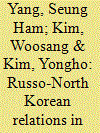| Srl | Item |
| 1 |
ID:
050935


|
|
|
| 2 |
ID:
065788


|
|
|
| 3 |
ID:
059463


|
|
|
|
|
| Publication |
Nov-Dec 2004.
|
|
|
|
|
|
|
|
|
|
|
|
|
|
|
|
| 4 |
ID:
178728


|
|
|
|
|
| Summary/Abstract |
Literatures on the influences of missile defense (MD) on the existing nuclear deterrence are divided into negative and positive perspectives. However, both sides seem to make contradictory arguments. Skeptics argue that it is not feasible that MD influences deterrence stability but that it causes security dilemma and arms race, while proponents suggest that MD does not have to be perfect to reinforce deterrence stability but that it does not cause security dilemma and arms race. To fix this logical inconsistency, we identify an additional variable which is crucial in understanding the security dilemma mechanism in addition to Jervis’s (1978) two variables. By adding another variable, a minimum MD effectiveness level required for deterrence success suggested by Quackenbush (2006), to Jervis’s framework, we develop three hypotheses, two of which are novel on MD and its potential influences on deterrence stability and arms race. We then introduce a probabilistic model of the MD effectiveness by modifying Wilkening’s (2000) and conduct simulation analysis to see if MD is more likely to incur security dilemma and arms race. Our simulation results show that MD influence is likely to be different depending on a potential challenger’s national capability. Against a great power challenger, MD is least likely to meet the minimum MD effectiveness level required for deterrence success, so that the challenger is more likely to respond flexibly to the defender’s buildup of MD. Against a newly nuclear-armed state, however, a defender’s MD is more likely to satisfy the minimum MD effectiveness level, so that the defender is highly likely to respond flexibly to the potential challenger’s reinforcement effort of its nuclear force. In either case, our simulation results indicate that arms races concerning MD among them are not likely to occur.
|
|
|
|
|
|
|
|
|
|
|
|
|
|
|
|